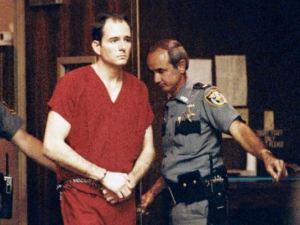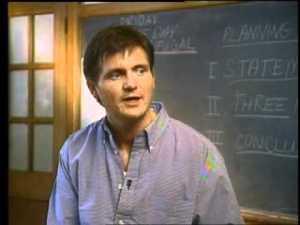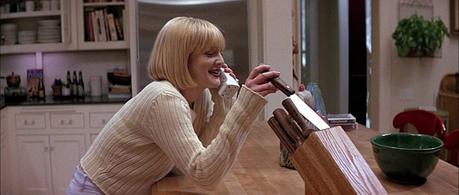“What’s your favorite scary movie?” And with that line Kevin Williamson found one of the greatest hooks in modern horror movie history – a slasher film about teenagers who grew up watching slasher films and know all of the simplistic rules of the genre, e.g., never say “I’ll be right back,” never have sex, etc. The famous story behind what became the Scream franchise is that it got its start when a dirt poor Williamson banged out a script in three days, calling it “Scary Movie.” He was so desperate for money that he also created outlines for what became Scream 2 and Scream 3, hoping to sweeten the deal for any interested studio by not only offering them a new movie but a new franchise. The Weinstein Bros. had to outbid Oliver Stone for the rights. Wes Craven kept turning down the chance to direct until an 11-year-old kid at a convention accused him of having gone soft. Yada, yada, yada.
It’s now four films later with a combined box office might of $604 million worldwide, and MTV just premiered a new TV series version of Scream, the network hoping to repeat the success they’ve enjoyed with Teen Wolf. This new Scream in’t connected to the films, but the story and character types (though not specific character names) are familiar: a high profile guest star (Drew Berrymore in the first movie, Bella Thorne in the Scream pilot) is killed off in the opening scene by a masked murderer thus setting up a murder investigation in an increasingly paranoid town, everything gradually linking to a virginal teenage girl and her suspicious boyfriend. It remains to be seen whether or not a slasher story can truly work as a TV series, which the Scream pilot even acknowledges via its stand-in for Jamie Kennedy’s movie-obsessed scene-stealer from Scream 1 and 2. As a TV show, Scream could play out like any number of other murder investigation shows, like Broadchurch as a teen drama in which several more characters die after the initial victim. It might turn out to be a perfectly entertaining summer series.
There was nothing entertaining about that central premise to the residents of Gainesville, Florida back in late August of 1990. On August 24, 1990, roommates Sonja Larson, 18, and Christina Powell, 17, were murdered by a masked man who raped one of the girls and posed their corpses in sexually provocative positions in their apartment. A day later, Christa Hoyt, 18, was murdered in her apartment, her decapitated head placed on a bookshelf, facing her naked body positioned on the edge of a bed. Larson and Powell were University of Florida students while Hoyt had attended Santa Fe Community College, and this all happened the weekend before the first Monday of the University of Florida’s Fall semester. As such, a panic quickly set in. Hundreds of students left town.
A mere two days after Christa Hoyt’s death, the killer claimed two more victims: Tracy Paules, a University of Florida pre-law student, and her roommate Manny Taboada, a Santa Fe student. They were both 23-years-old and lifelong friends, Taboada having been a football star.

Gainesville honors and remembers the victims
This was the work of an actual real life serial killer, dubbed the Gainesville Ripper by the media. This would have been shocking to any community, but the fact that it took place roughly over a 72-hour period (if you start from the point that authorities found the first victims) made it particularly traumatizing, especially since Gainesville’s yearly homicide rate was normally in the single digits. There were no additional murders, but everyone had to live in fear and obsessively follow the updates on the investigation. University of Florida students withdrew their enrollments or transferred to other schools. Students were encouraged to sleep together in groups, relying on strength in numbers. All local gun stores quickly sold out their existing inventories due to an increasingly paranoid populace. Authorities conducted the largest manhunt in Florida history, identifying 675 suspects and 18,000 pieces of evidence, but across a year-long investigation they missed key evidence and wrongfully arrested an innocent, scarred schizophrenic University of Florida student whose face was plastered all over news reports.
As it turned out, the real killer, Danny Harold Rolling, had actually been in prison almost the entire time, arrested 40 miles outside of Gainesville after attempting to rob a grocery store a week after Christa Hoyt’s body had been discovered. He was already suspected of robbing a bank the same weekend as the killings meaning at the time of his arrest they had finally nabbed a pesky burglar. They only started connecting the dots once they discovered that a similar murder had occurred in Louisiana almost exactly a year prior and the authorities there suspected Rolling. When they found the camp site Rolling had been using to hide in the woods they found all the evidence they needed to connect him to the killings, formally charging him with murder in November 1991. They convinced him to plead guilty the morning his trial was set to begin in February 1994.

Danny Harold Rolling was eventually executed on October 25, 2006
One of the investigators told The Discovery Channel that while he was working the case he’d “wake up in the middle of the night, check the doors, rattle the windows, make sure everybody was safe and secure.” That’s exactly what you’d expect from someone having to live and breathe such a disturbing case. However, even reading about it (or in my case writing about it) is kind of unsettling.
Now imagine that you’re Kevin Williamson. It’s March 1994. You haven’t been living in Los Angeles that long, leaving behind potential acting jobs in New York to become a Hollywood screenwriter. It’s not going so well. You’re making money through temp jobs and working as an assistant to a music video director, and you’ve yet to write your first script, still battling a lack of confidence after a teacher once warned, “You can’t spell, your grammar’s awful, and you’re from the hills of North Carolina-it’ll never happen!” You have to borrow money from a friend to attend a screenwriting course at UCLA, and when another friend offers you money to housesit for them you can’t say no.

Kevin Williamson circa 1996
So, you’re alone in a strange house, watching TV late at night and feeling a bit lost in life. You come across ABC’s hour-long documentary series Turning Point, whose latest episode is all about the Gainesville Ripper. The accounts of his killings and the terror they brought to an otherwise peaceful community sounds like something straight out of your favorite horror movie, Halloween. Danny Rolling only recently pleaded guilty, and a 10-week trial is being conducted to determine whether or not he deserves the death sentence. Suddenly, any extra creak in the floorboard in the house sounds extra loud, and that mysteriously opened window letting the breeze come in freaks you the fuck out! You call a friend to talk about the Gainesville Ripper, but instead you two quickly begin discussing your favorite scary movies.
Eureka!
What if you write a script that would be like When a Stranger Calls for the VCR generation of teenagers who really know their horror movies, someone talking on the phone with somebody who could be a killer and is using her love of horror movies to torment her?
Williamson turned that into an outline, thinking of it as maybe a one-act play or short story.

Near the end of Scream, one of the killers argues, “Movie’s don’t create psychos, movies just make psychos more creative.” That was Williamson’s rebuttal to Republican Presidential candidate Bob Dole condemning “entertainment executives for debasing the nation’s culture” by making movies like Natural Born Killers and True Romance. However, in some small way it was a real life psycho, Danny Harold Rolling, who actually inspired the creation of Scream. Kevin Williamson allowed a true life horror story to scare him, and he turned around and made a fictional horror story that scared the world over and over and over again to the point that it’s now a TV show.
Source: Reel Terror, LA Times, Serial Killers – Danny Rolling Documentary, The Inside Story: Scream!

